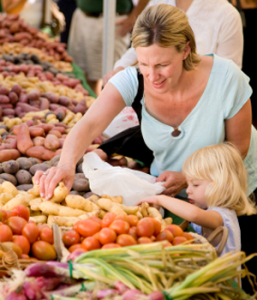Eating healthy can be costly, especially if you are choosing to buy organic foods. Most organic foods cost at least 50 % or more than conventionally grown foods. Eating healthy is an investment in your health and shouldn’t eat up all your savings. The good news is you can still purchase whole foods without breaking the bank.
1). Make a grocery list and stick to it
Make a grocery list based on your weekly menu plan to avoid temptation while grocery shopping. Try to limit your trips to the grocery store to no more than 2 times/week.
2). Make a weekly menu plan
Menu planning helps organize you and your families meals; improves nutrition , minimize waste, avoid multiple grocery store visits, saves money and time.
3).Eat seasonally
Foods that are in season are less expensive , more flavorful, and healthier. During the winter months for go the expensive, imported, and tasteless strawberries. Freeze batches of berries during summer months for the winter.
4). Visit Farmers markets
Pack up the family and visit your local farmers market, before buying, take a stroll and check the prices. Visit the market regularly and you’ll get to know which farmers have the best prices. Don’t forget your list!
Bonus: Farmers markets are a great place for children to learn about food, where they come and how they are grown.
5). Chose fruits and vegetables from the ” dirty dozen” list
According to a non profit group called the Environmental Working Group (EWG) , certain fruits and vegetables such as apples, strawberries, and green leafy vegetables contain more pesticides than others. The EWG has developed a “dirty dozen” guide which they recommend people to chose organic. Like wise, the EWG has “clean 15” list which contain fewer pesticides regardless of how they are grown.
Choosing to buy “organic” can be costly , some health experts agree that if health is the reason you buy organic, you can save money buy choosing fruit and vegetables from “dirty dozen ” guide and buy conventionally fruits and vegetables from the “clean 15”
6). Look for private labels brands
Store organic brands such as Safeway’s “organics” or Wholefoods’ “365” are often significantly less expensive, sometimes less than non organic foods, and follow the same standards as brand name organic producers. Remember to always read the labels.
7). Start your own garden
Herbs, lettuce, beets, tomatoes, and strawberries can easily be grown on a patio and are cost effective.
Get the kiddies involved, allow them to chose their own plant and water it throughout the season.
8). Become a CSA member
Community supported agriculture (CSA) is a model that connects both the farmer and consumer. The consumer helps with expensive start up costs at the beginning of the season in exchange for fresh, locally grown produce. Both the consumer and farmer also share the risks and benefits of the food production. Shares are usually $ 300-400 a year depending on the size for a weekly basket of seasonal produce, which can work out to $30/week. Bonus you will probably get some produce that you wouldn’t necessarily buy on your own, encouraging you to be more creative. To find a local CSA in your community go to www.eatlocal.org
9). Buy Bulk
Purchase nuts, seeds, lentils, and grains in bulk ; you buy what you need and often cost less. Another bonus, foods found in the bulk bins are fresher that those sitting on the self waiting for you to buy them. If you or someone in your family has food allergies you may want to think twice due to possible cross contamination.
10). Eat less meat
Meat is the most expensive item on your grocery list. Start replacing meat with inexpensive and nutrient dense proteins such as beans and lentils. Buy them bulk and you’ll save even more.
11). Organize your pantry
Organizing your pantry and storing lentils, grains, flours with labels will help keep food fresh and make your task of meal planning easier.
12). Creativity
At the end of the week use some creativity to use up left over vegetables, grains, protein instead of letting them go bad. A great and quick way to use leftovers is to create a stir fry, omelet, or salad.
13). Storage
Always store produce, grains, flours, and nuts properly to prevent waste. Looking for some produce storage tips check out this great post fromloveandlemons.
.


No comments yet.